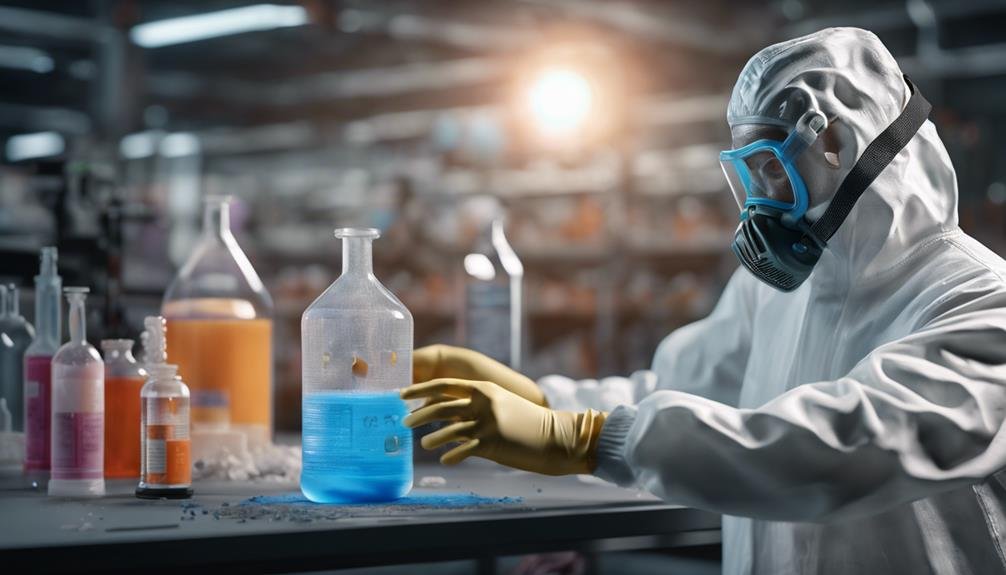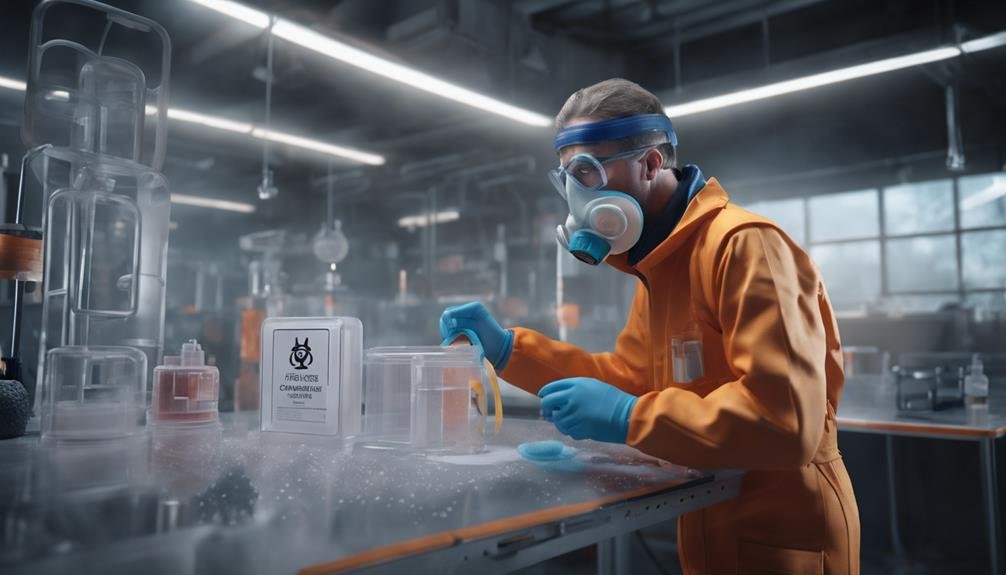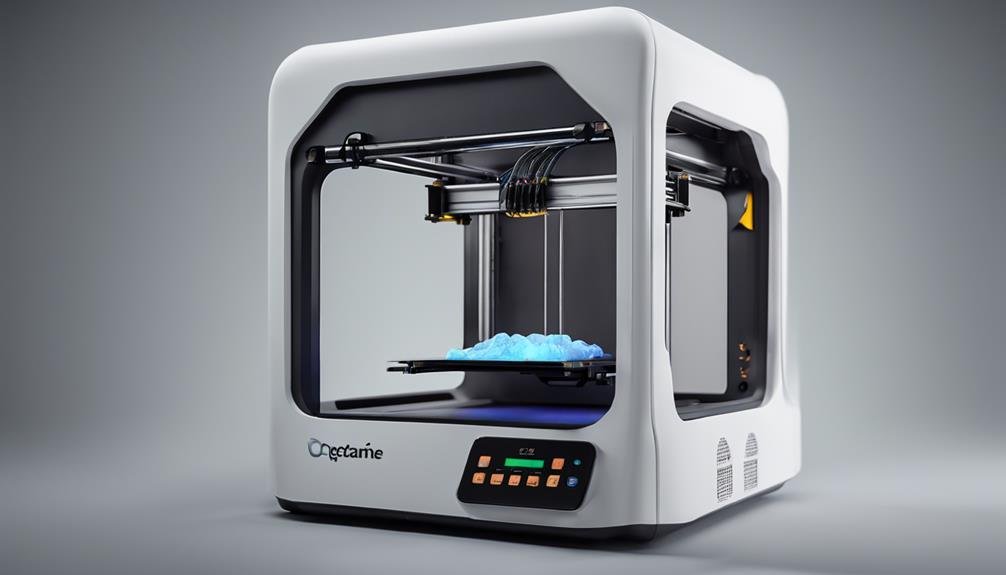3D printing can be toxic due to emissions from filaments like ABS, PLA, and PETG, raising health concerns. These materials can emit carcinogenic fumes and cause chronic health issues, emphasizing the importance of caution. Proper ventilation and safety precautions are essential when using 3D printers to minimize risks. Understanding the impact of different filaments on your health is critical as they can vary in toxicity levels. Safety guidelines provided by companies should be followed strictly to safeguard your well-being. Be aware of the potential health risks associated with 3D printing materials to protect yourself.
Potential Health Risks of 3D Printing
Exposure to certain 3D printing filaments poses potential health risks that warrant attention and caution. When engaging in 3D printing activities, it's important to take into account the fumes emitted by filaments such as ABS, which are known to be toxic and carcinogenic. These fumes can have adverse effects on your respiratory system and the general air quality.
Moreover, filaments like PLA and PETG, while considered safer alternatives, still carry risks of causing chronic health effects with prolonged exposure. The long-term health impacts of using different 3D printing materials remain uncertain, necessitating a proactive approach to safeguarding your well-being.
To mitigate potential health hazards associated with 3D printing, it's advisable to prioritize proper ventilation in your workspace to reduce the concentration of harmful fumes. Monitoring and improving indoor air quality during printing sessions can help minimize the risks posed by these materials.
As awareness grows regarding the dangers of certain filaments, it's possible that warning labels may become mandatory in the future, akin to the cautionary measures seen on cigarette products.
Toxic Emissions During 3D Printing
During 3D printing, harmful fumes are emitted by certain filaments, such as ABS, known for their toxicity and carcinogenic properties. These printing fumes can pose significant health risks to individuals exposed during the printing process. Filament manufacturers play an important role in ensuring the safety of their products by providing detailed information about the potential health effects associated with their filaments.
It is vital to understand that ABS filaments, in particular, release toxic fumes that can have adverse effects on respiratory health. Furthermore, PLA and PETG filaments, though considered safer, can still lead to chronic health issues due to the release of nanoparticles from oil-based products.
The lack of detailed data on the long-term health impacts of 3D printing filaments underscores the importance of exercising caution when working with these materials.
Therefore, individuals engaging in 3D printing activities should prioritize safety measures and seek guidance from filament manufacturers regarding the potential health risks associated with specific filaments.
Impact of Materials on Human Health

Materials used in 3D printing can have significant impacts on human health, particularly in relation to the potential toxicity and long-term health effects associated with certain filaments. Filaments such as ABS are well-known for their toxic and carcinogenic properties, posing risks to both users and the environment.
Even filaments like PLA and PETG, often considered safer alternatives, can lead to chronic health issues with prolonged exposure. The volatile organic compounds (VOCs) released during the printing process can have adverse effects on respiratory health and general well-being.
Despite the growing awareness, there remains a lack of detailed data on the long-term health consequences of using different 3D printing materials. This gap in knowledge underscores the importance of implementing precautionary measures and potentially mandating warning labels to inform users about the potential health risks associated with different filaments.
As the concerns surrounding the impact of materials on human health continue to grow, prioritizing safety in 3D printing practices becomes paramount to safeguarding individuals from avoidable health hazards.
Carcinogenicity Concerns in 3D Printing
Carcinogenicity risks associated with 3D printing materials raise significant concerns for human health and safety. While ABS filaments are widely acknowledged as toxic and carcinogenic, alternatives like PLA and PETG also warrant attention due to their potential carcinogenic properties. Prolonged exposure to these filaments has been linked to cancerogenic effects, emphasizing the importance of understanding the risks involved in 3D printing.
Sensitivity to different filament materials varies among individuals, underscoring the need for thorough safety measures in this rapidly expanding industry. The long-term health consequences of using different printing materials remain inadequately understood, highlighting the necessity for further research to establish clear guidelines for mitigating potential risks.
As you navigate the world of 3D printing, it's important to prioritize your health by staying informed about the potential carcinogenicity of materials like PLA and PETG, especially considering the uncertainties surrounding long-term exposure.
Chronic Health Effects of 3D Printing

The potential chronic health effects of 3D printing materials demand careful consideration to safeguard your well-being.
When using 3D printing filaments, it's crucial to be aware of the following:
- Variability in Sensitivity: Individuals exhibit different reactions to different printing materials. What may be harmless to one person could trigger health issues in another. Understanding your body's responses is crucial when working with 3D printing filaments.
- Risk of Chronic Health Effects: Certain filaments commonly used in 3D printing, such as ABS, PLA, and PETG, carry potential risks of chronic health effects. Prolonged exposure to these materials could result in adverse consequences on your health.
- Uncertainty in Long-Term Effects: The long-term health implications of using 3D printing filaments aren't yet fully understood. Continuous research and engineering efforts are crucial in uncovering and addressing any potential risks associated with these materials. Stay informed about emerging findings to protect yourself from any unforeseen chronic health issues.
Need for Enhanced Safety Measures
Investing in 3D printers equipped with advanced safety features is vital for mitigating the potential health risks associated with toxic filament printing. To improve safety during 3D printing, it's important to explore printers with HEPA filters, carbon filters, and small ventilation systems. These features help in filtering out harmful particles and fumes generated during the printing process, thereby reducing the risk of exposure to toxic substances.
Manufacturers are increasingly focusing on providing printers with professional filtration systems to create a safer printing environment. Users are willing to pay more for printers with upgraded safety features, prioritizing health considerations over factors like print quality and speed.
Airtight printers with effective ventilation and strong filtration systems play a significant role in combating the toxicity of certain printing materials. Therefore, when engaging in 3D printing with potentially hazardous filaments, opt for printers that offer robust safety measures to safeguard your well-being.
Importance of Better Filtration Systems

Improving filtration systems in 3D printing is vital for reducing exposure to potentially harmful particles and fumes. To achieve this, consider:
- Enhanced Filtration Technology:
Upgrading to advanced filtration systems, such as Bambus carbon filters, can help trap volatile organic compounds (VOCs) released during the printing process. These compounds are known to cause health issues upon inhalation.
- Capture of Ultrafine Particles:
Current filtration systems may struggle to capture ultrafine particles that are released into the air during 3D printing. Strengthening the filtration mechanisms to effectively capture these tiny particles is crucial for maintaining a safe working environment.
- Optimizing Airtightness and Ventilation:
Engineering challenges around ensuring proper airtightness and ventilation in filtration systems need addressing. By enhancing these aspects, the efficiency of the filtration system can be improved, leading to better removal of harmful substances from the air.
Call for Stringent Regulations
To address the concerning lack of regulations regarding toxic 3D printing filaments, stringent measures are imperative to guarantee consumer safety and prevent potential legal ramifications.
The unregulated presence of volatile organic compounds (VOCs) in 3D printing materials poses a significant risk to users. Without proper regulations mandating safety warnings on these filaments, consumers are left unaware of the potential health hazards they may be exposed to.
Companies must be held accountable for providing clear and explicit safety guidelines to protect their customers from harm. The absence of strict regulations in the 3D printing industry mirrors past issues with hazardous chemicals, emphasizing the urgent need for specific guidelines.
Failure to implement these necessary precautions could result in a surge of legal actions against businesses that neglect to inform users about the toxicity of their products. Therefore, enforcing strict regulations and safety warnings is crucial to safeguard the well-being of individuals utilizing 3D printing technology.
Frequently Asked Questions
Is 3D Printing Harmful to Health?
3D printing can pose health risks due to chemical exposure from toxic particles in filaments like ABS, PLA, and PETG. Long-term effects are concerning, prompting the implementation of improved safety measures like advanced filtration systems for user health protection.
Is It Safe to Breathe Around a 3D Printer?
Breathing around a 3D printer can pose risks due to poor air quality from filament emissions. Health concerns include respiratory issues from particle exposure. To stay safe, guarantee proper ventilation and use air filtration systems to reduce health risks.
Is It Safe to 3D Print Indoors?
When 3D printing indoors, guarantee proper ventilation, opt for safe filaments like PLA and PETG, and be mindful of fire hazards. Regular maintenance minimizes fume exposure. Use an enclosure with effective filtration for added safety.
Is It Safe to Be Near a 3D Printer?
Being near a 3D printer demands caution. Guarantee good ventilation and monitor air quality. Reduce exposure to chemical emissions by practicing safety precautions. Take care of your health by being mindful of potential risks.
Conclusion
To sum up, it's vital to recognize the potential health risks associated with 3D printing. From toxic emissions during the printing process to the impact of materials on human health, there are serious concerns that must be addressed.
By implementing improved safety measures, such as better filtration systems and stringent regulations, we can work towards minimizing the risks and ensuring the safety of both users and the environment.
Stay informed and prioritize safety when engaging in 3D printing activities.
Contents
- 1 Potential Health Risks of 3D Printing
- 2 Toxic Emissions During 3D Printing
- 3 Impact of Materials on Human Health
- 4 Carcinogenicity Concerns in 3D Printing
- 5 Chronic Health Effects of 3D Printing
- 6 Need for Enhanced Safety Measures
- 7 Importance of Better Filtration Systems
- 8 Call for Stringent Regulations
- 9 Frequently Asked Questions
- 10 Conclusion